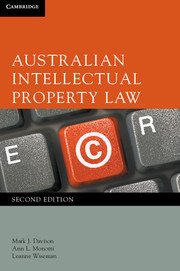Book contents
- Frontmatter
- Contents
- Preface
- Acknowledgements
- Table of statutes
- Table of cases
- 1 Introduction
- 2 Passing off
- 3 Registered trade marks
- 4 Exploitation of registered trade marks
- 5 Copyright: introduction
- 6 Subsistence of copyright
- 7 Authorship and first ownership, nature of the rights and duration
- 8 Exploitation, infringement and defences
- 9 Moral rights, performers’ rights, artist's resale rights, and other rights
- 10 Designs
- 11 Equitable doctrine of breach of confidence
- 12 Patents for inventions: introduction
- 13 Patents for inventions: validity
- 14 Patents for inventions: allocation of rights and ownership, the Register and dealings
- 15 Patents for inventions: exploitation, infringement and revocation
- 16 Plant breeder's rights
- 17 Remedies and miscellaneous issues
- Index
- References
12 - Patents for inventions: introduction
- Frontmatter
- Contents
- Preface
- Acknowledgements
- Table of statutes
- Table of cases
- 1 Introduction
- 2 Passing off
- 3 Registered trade marks
- 4 Exploitation of registered trade marks
- 5 Copyright: introduction
- 6 Subsistence of copyright
- 7 Authorship and first ownership, nature of the rights and duration
- 8 Exploitation, infringement and defences
- 9 Moral rights, performers’ rights, artist's resale rights, and other rights
- 10 Designs
- 11 Equitable doctrine of breach of confidence
- 12 Patents for inventions: introduction
- 13 Patents for inventions: validity
- 14 Patents for inventions: allocation of rights and ownership, the Register and dealings
- 15 Patents for inventions: exploitation, infringement and revocation
- 16 Plant breeder's rights
- 17 Remedies and miscellaneous issues
- Index
- References
Summary
What is a patent for invention?
A patent is granted by the Crown and confers private property rights in the form of a monopoly for the invention of products, methods and processes in all fields of technology. The invention could relate to all manner of things including pharmaceutical products and processes, engineering products and processes, medical and therapeutic devices, micro-organisms and computer technology. These things all have in common some human intervention with nature to bring about some physical change. A patent grants exclusive rights to the patentee in relation to the invention in return for public disclosure of the invention.
Patents are available for two tiers of inventions: standard patents and innovation patents. Neither patent will be granted for something that is already known. The invention must be novel, in the sense that its details are not published or made publicly available through use anywhere in the world. The invention must also be useful. Different levels of an advance over what is known apply to standard and innovation patents. The standard patent must not be obvious – it must involve an inventive step – whereas an innovation patent requires a substantial contribution to the working of the invention.
- Type
- Chapter
- Information
- Australian Intellectual Property Law , pp. 409 - 435Publisher: Cambridge University PressPrint publication year: 2011



